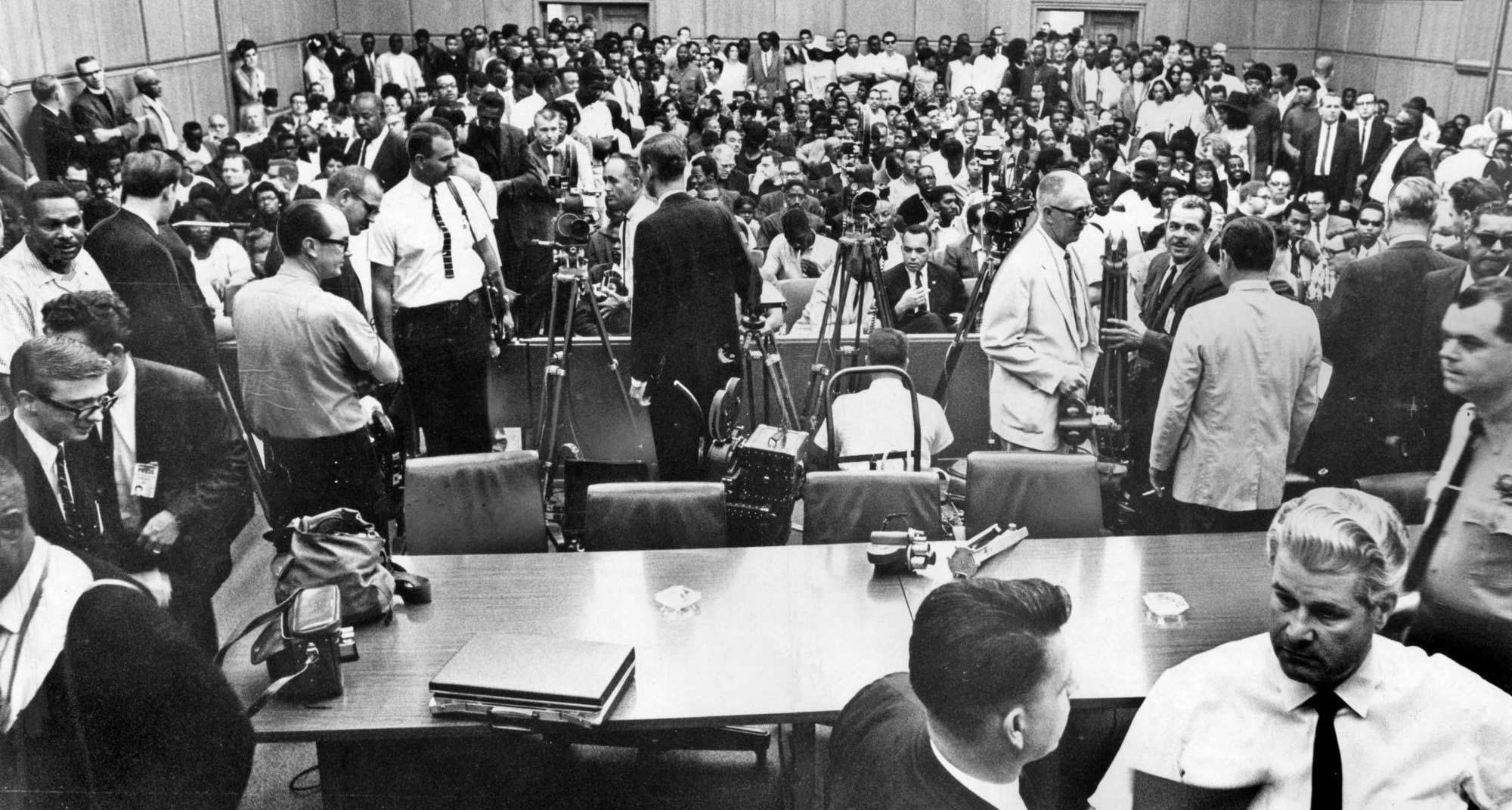
When police officers kill someone, can inquests get answers for the public?
The motorcycle cop flashed his lights. The motorist, a despondent war veteran, took off on a wild dash down the Hollywood Freeway. When it was over, the veteran was dead, shot through the heart.
Less than a week later, amid a public clamor for answers, the Los Angeles County coroner convened a hearing with a judge and jury to decide whether the shooting was justified.
Over the next two days, accounts of the incident were told by 42 witnesses, including the officer who recalled in minute detail the events that led him to shoot.
"His door swung open and all I could see was a figure charging at me," 28-year-old Maurie Goldstein testified. "I tried to back away from him because his one hand was clutching at me. I felt my life was in danger. I raised my gun and fired."
The year was 1952, the height of an era when the official response to a fatal police shooting routinely began with a public, and often dramatic, coroner’s inquest, a quasi-judicial proceeding with roots in 12th century England.
The inquest was intended to give a swift and open airing — sometimes on live TV — of the circumstances surrounding a death, and to render a verdict: accidental, justifiable or criminal homicide. Though not binding, the verdict often ended the matter, as it did when the jury determined Goldstein was justified in shooting.
In the following decades, inquests fell out of favor; the last one in L.A. was held in 1981. So much has the pendulum swung that today officer‘ accounts of shootings are buried in months of investigation and are seldom examined in public.
Now, with frustration boiling in Los Angeles as well as cities such as Ferguson and Baltimore over the handling of killings by police, some legal analysts and public officials are asking whether the inquest — or a modified form of it — could be revived as a vehicle to increase public access to information.
At the urging of County Medical Examiner-Coroner Mark A. Fajardo, who reviewed all police shootings in his job as Riverside County coroner, the Los Angeles Board of Supervisors has asked key agency heads to rethink the review process with an eye to increasing transparency.
Fajardo, who became L.A.’s coroner in 2013, said he found it "troubling" that the office had no review procedures.
"I think the Department of Medical Examiner-Coroner should have a process that assures quality, assures efficiency and is transparent in some respect," Fajardo said.
He said he considered calling an inquest into the Los Angeles Police Department’s fatal shooting of Ezell Ford last year, but held back because he hadn't fully vetted the process. The county is still reviewing various options.
In an article to be published this summer in the Yale Law & Policy Review, Paul MacMahon, an assistant professor at the London School of Economics, argues that a revamped inquest procedure could serve an important role both for accountability in wrongful deaths and "helping the deceased’s family come to terms with a traumatic death."
But there is little chance the trial-like proceedings of past decades will ever be seen again. The ideals of speed and transparency today face huge hurdles in the reality of complex forensics and the protections of police-officer privacy that have become deeply entrenched in state law.
The obstacles to the inquest as a forum for releasing circumstances of police-involved killings and for guiding prosecutors are apparent in several American counties that still practice them.
Facing public clamor for answers, Coroner Dan Blasdel of Franklin County, Wash., called an inquest into the fatal February police shooting of an unarmed Latino man. Blasdel announced that he would convene six civilian jurors on May 1 to decide whether the shooting was justified.
But Franklin County Prosecutor Shawn Sant blocked a quick review, saying investigative files would not be available until after his office decided whether to file charges, some time this summer.
Clark County, Nev., dropped its automatic coroner’s inquest process in 2010 after the police union successfully challenged it in court.
In its place, county commissioners set up a system that achieves some transparency at the expense of immediacy.
After every killing by police, if the district attorney finds no cause to prosecute — which has almost always been the case — the county manager convenes a hearing to examine the evidence in public. The prosecutor calls witnesses, primarily the officers who investigated the slaying. A hearing officer and ombudsman, both appointed by the county manager, can call and question witnesses in a cross-examination format, but not under oath. The officers involved in the killing do not testify.
Anyone attending the hearing can submit questions to the hearing officer or ombudsman, who is appointed to represent the public and the deceased’s family. The whole proceeding is live-streamed on the county TV station and the videos are posted on the county manager’s website.
No findings are made. "It simply concludes," said Robert Daskas, the deputy who oversees the district attorney’s response team.
There are critics, among them the Nevada ACLU, who say the new process is toothless. But Daskas credits it for easing the tension surrounding troubling events.
"We all see the protests and the riots," Daskas said. "I would like to think that one of the reasons we have not had issues like that in Clark County is because we provide a very transparent review of officer-involved shootings."
MacMahon, the English economist who has studied America’s inquest tradition, finds the Clark County process an admirable compromise. He argues that it is the very toothlessness of such reviews that give them the healing power that he calls "soft adjudication," a hearing process that is investigatory, rather than adversarial, and non-binding.


"Precisely because their verdicts do not carry binding or coercive consequences … inquests can aim more squarely than other legal proceedings at establishing the truth about a contested event," MacMahon writes in his article.
That description harks back to the three decades following World War II when the inquest was a communal — and arguably cathartic — ritual for probing Los Angeles’ gangster subculture, Hollywood drama and racial turmoil.
Among the most titillating was the 1958 inquest that found the 14-year-old daughter of actress Lana Turner justified in fatally stabbing her mother’s gangster boyfriend, Johnny Stompanato.
But most high-profile inquests dealt with police shootings. The 34 deaths during the Watts riots of 1965 set off a frenzy of inquests that ultimately brought the process itself into disrepute.
Although the record of the outcomes of those inquests is largely lost, James N. Adler, a lawyer who consulted for the McCone Commission, which studied the riots, said he recalled that no officer was found to have acted unlawfully.
Criticism of the inquest process crystallized with the 1966 case of Leonard Deadwyler, a 25-year-old black man who was fatally shot after leading police on a chase along Avalon Boulevard.
Deadwyler was taking his pregnant wife to General Hospital when officers tried to pull him over. After the chase he was shot by an officer who thrust his torso into the car window and later said he fired accidentally when the car lurched forward.
A group called the Committee to End Legalized Murder By Cops led protests before the eight-day inquest, and throngs of mostly black onlookers filled the downtown courthouse as 49 witnesses, including the officer involved, testified.
After a nine-member jury found the killing justified, the NAACP’s Legal Redress Committee issued a report comparing the proceeding to a Roman circus.
"It’s a staged performance, an Emmy-awardable TV production, in which the only players who don't know their lines are the Deadwyler witnesses," the report said.
Dist. Atty. Evelle J. Younger and county Coroner Theodore J. Curphey, who was pushing to recast the office in the medical-examiner model, judged the institution anachronistic.
In a paper published in the 1967-68 UCLA Law Review, Adler recommended abolishing the practice.
"It seems clear in light of the Watts inquests that the inquest no longer serves any necessary or legitimate function in our present-day society," Adler wrote.
In 1969, the Legislature changed the inquest law, eliminating the finding of "unlawful killing" as a possible verdict.
L.A.’s flamboyant Medical Examiner-Coroner Thomas Noguchi called several more inquests that only increased public doubts. The inquest into the death of L.A. Times reporter Ruben Salazar after the riotous 1970 Chicano Moratorium devolved into a protest and walkout. Activists called it a whitewash for the sheriff’s deputy who fired the tear-gas projectile that killed Salazar as he sat in a bar.
Noguchi refrained from calling an inquest in 1979 after two police officers shot a black woman on her porch when a dispute over a gas bill turned volatile.
L.A.’s final inquest occurred in 1981 after Cal State Long Beach football star Ron Settles died by hanging in a Signal Hill jail cell. After hearing 10 days of testimony, a jury split 5-4 in deciding that Settles’ death was "at the hands of another." The dissenting jurors voted to rule the death a suicide.
Three months later, Dist. Atty. John Van de Kamp declined to prosecute, citing insufficient evidence. His decision was unsatisfactory to both the Settles family, who believed that police murdered Ron, and the prime suspect, who said he should have been declared innocent.
Noguchi was soon demoted by the Board of Supervisors. None of his successors has called an inquest.
The process for reviewing police conduct was updated after the Rampart scandal of the late 1990s. Since 2001, the district attorney maintains a team that investigates every incident in which police cause an injury.
Deputy district attorneys go to the scene, interview witnesses and write a sometimes lengthy assessment. In contrast to the practice in Clark County, Nev., there is no public hearing and the reports are not posted publicly.
A Times review of more than 600 of those reports, obtained under the Public Records Act, shows that the conclusions are almost always based on statements from the officers involved and the agency’s investigators. None of the cases reviewed by The Times resulted in a finding of unlawful activity.
Adler, whose post-Watts critique contributed to the demise of the inquest, conceded that the system replacing it is also potentially flawed.
"We've got the police making their own internal investigation; we have the D.A. determining whether to prosecute," Adler said. "In practice, this has not turned out to be a very satisfactory method of investigating potential police misconduct. The process is not seen by much of the public as being either transparent or inclusive."
And he’s not optimistic it can be fixed without starting out from scratch.
"Could you build something that was better, more transparent and fair? Perhaps," Adler said. "I don't know exactly what it would look like."
Contact the reporter Doug Smith.


